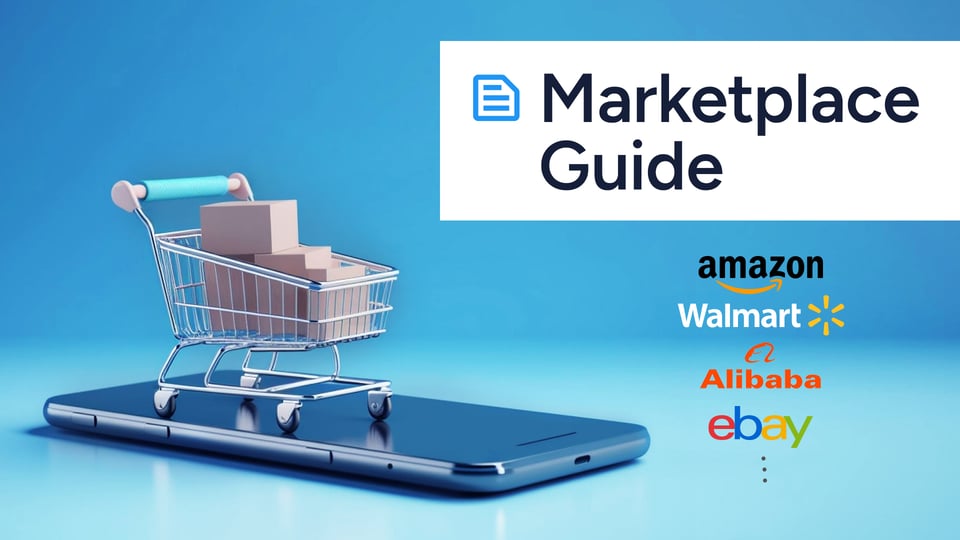The adoption of online marketplaces as a strategic sales channel has proven to be a lucrative venture for businesses across the globe. As a $3.2 trillion industry, ecommerce marketplaces have become fertile ground for retailers and brands to reach more consumers or expand into new regions with ease.
Even better news? The sales lift these businesses have seen as a result of ecommerce marketplace adoption shows no signs of deceleration anytime soon.
Now imagine you can compound those business benefits by selling on multiple marketplaces at once. That’s what the most innovative leaders in ecommerce are already doing. And here’s why.
The most valuable benefits of selling on multiple marketplaces
Today, according to Deloitte Digital, online marketplaces are among the biggest drivers of ecommerce growth: a trend that exploded during the onset of the COVID-19 pandemic and has only seen continued growth over time.
Do you want to find ways to:
- Expand your customer base and reach a wider audience?
- Scale your business globally with cross-border ecommerce?
- Sell products more quickly and cost-effectively?
- Gain valuable data on customer behavior, product performance, and trends?
Then selling on multiple marketplaces may be the accelerator your organization needs to meet those goals.
Last year, studies revealed that retailers are already garnering 38% of their commerce sales via marketplaces. Among those retailers, 25% are actively looking to sell across varied marketplaces in the future, and hoping to see growth beyond Amazon. It’s clear that businesses’ interest in selling on multiple marketplaces is there. Now, there’s just the question of how to get started, and how to get it right.
Challenges of Selling on Multiple Marketplaces
While selling on multiple marketplaces can significantly increase your sales reach, it also introduces a range of operational challenges that can hinder your growth if not managed properly. Here are some key difficulties sellers often face:
Inventory management across platforms
Managing inventory on a single marketplace is already a demanding task, but when you’re operating across several platforms—each with different rules and requirements—it becomes even more complicated. Overselling, stock shortages, and discrepancies between platforms can quickly arise if your inventory isn’t updated in real time across all channels.
Varying rules and guidelines
Every marketplace has its own set of rules and guidelines for listings, pricing, and promotions. Keeping up with these constantly changing policies can be overwhelming, and failing to comply could result in penalties or even account suspension.
Order and fulfillment complexities
Handling orders from multiple marketplaces means dealing with different shipping requirements, customer support standards, and return policies. Coordinating these operations efficiently, especially during peak sales periods, can be a logistical nightmare without the right tools.
Data fragmentation
Selling across several platforms leads to fragmented data—orders, customer interactions, and sales performance reports may be stored in different systems, making it difficult to have a holistic view of your business. Without centralized data, it becomes harder to make informed decisions and optimize performance.
Overcoming marketplace complexity
Selling on multiple marketplaces presents a host of challenges, but it also creates growth opportunities. To help you navigate this complex landscape more efficiently, we’ve created an ebook, "10 Hacks to Simplify Marketplace Selling," which provides actionable insights to simplify your workflows and reduce manual processes.
Seven essential considerations for selling on multiple marketplaces
Before you take the leap and start your multichannel selling journey, ensure you're well-prepared. Below are seven of the top considerations for ecommerce brands.
1. Do your research
Not all marketplaces are created equal. Choosing the right one for your business to sell on can make or break the success of your marketplace strategy.
This means you need to be careful in your choices. Cover your bases and start with high-volume marketplaces with large market share, like Amazon, then supplement with more niche marketplaces suitable to your vertical or target region.
Your research could start with desk research for marketplace options, but you could also dive into which marketplaces your competitors are selling on, or reach out to your network to learn if there are niche or industry-specific marketplaces you may not be aware of.
Be sure to consider whether a multinational marketplace makes sense for your business, or if focusing on one particular country is a better way to reach your target audience. The top marketplaces in Europe and around the world are always evolving, so ensure that you frequently refresh your knowledge. You don't want to miss an emerging market that could be the perfect springboard for your brand!
2. Connect your back-end software
For ecommerce brands selling on multiple marketplaces, it’s essential to connect your back-end systems (i.e. ERP, WMS and PIM systems) to the marketplaces you’re selling on. This can be achieved with marketplace integration software and enables accurate inventory levels, up-to-date product information, and helps you to avoid overselling. If your systems are integrated, you'll also be able to forecast inventory for stock replenishment more effectively.
For those overlooking software to assist with integration management, the admin work required to manage listings across several different marketplaces, combined with order, fulfillment, and advertising, poses a huge challenge.
3. Automate when possible
Automation is a critical part of improving e-commerce operational efficiency. If you’re interested in offloading some manual work across your organization, it's highly likely that there are some ecommerce technologies that can help.
If there are any existing processes in your business that are repetitive or highly manual, there’s a good chance that you can find a way to automate them — especially in the era of artificial intelligence. Start small and tackle your ecommerce operations — whether it’s inventory management, listing management, order fulfillment, or logistics — one process at a time.
4. Understand your fulfillment requirements
On the topic of order fulfilment, it's to ensure ahead of time that you’re set up for success. B2B2C fulfillment, in particular, can be complex if products need to be moved between manufacturers, distributors, and end consumers seamlessly.
If your organization requires support in some aspects of your shipping operations, outsourcing third-party logistics to a marketplace could make sense. However, keep in mind that while you benefit from the scalability, time- and cost-savings, and expansion capability of outsourcing fulfillment services, you do also lose some control over last-mile delivery and customer experience.
If you're weighing up the 1P vs 3P selling model decision, ask yourself the following questions:
- Is third-party fulfillment an option for my business, or does a high-degree of industry regulation require more in-house control?
- Should I consider the marketplaces’ own fulfillment services (i.e. Fulfillment by Amazon)?
- Can I use my existing fulfillment processes on other marketplaces? (Amazon multichannel fulfillment, for example)
- Are there any disadvantages to outsourcing fulfillment, for my particular business, that I may be overlooking?
Make sure you have answers to these and all your burning questions before jumping headfirst into multi-marketplace selling.
5. Find the right advertising options
How can you advertise your products on multiple marketplaces?
First and foremost you need to know the ins and outs of each marketplace’s advertising platform, and then tailor your ad strategy to that marketplace’s particular algorithm.
What’s the value of paid vs. organic search? Sponsored ads? Influencer marketing? What’s the potential for driving offsite paid traffic to your marketplaces?
Understand how each marketplace you choose to sell on can serve as a business driver and a unique advertising platform. Then, launch your strongest ad content and make an impression.
Amazon, for example, is brimming with first-party data ripe for use in targeted advertising: offering brands who leverage the marketplace a better, privacy-centric way to personalize, a more targeted approach to upselling, and seamless shopping experience from a highly- and widely-trusted marketplace.
With partners like Amazon, you can promote your brand with sponsored products, PPC ads, or display ads that put your best content in front of a huge, relevant audience with ease. Plus, today, retail media accounts for 11% of global ad spend, and that number is projected to grow by as much as 60% by 2027 . If you don’t start leveraging these marketplaces to reach buyers, your competitors certainly will.
6. Optimize your pricing
Consider how you will determine pricing across your marketplaces, and how you will keep it consistent across channels. It’s essential that you set the optimal price for your products across every marketplace you're present on.
This isn't the only pricing question to consider. Ask yourself:
- Does your chosen marketplaces use a Buy Box? If it does, you'll need repricing software to help you to win it.
- Will my marketplace presence impact how consumers perceive my brand? Will my brand be negatively impacted if we're featured in a highly price sensitive environment, for example?
- Could online marketplace sales cannibalize website sales, and if so, what is the profitability trade-off?
7. Select your marketplaces strategically
Ensure the marketplaces you decide to sell on are suitable for your brand, especially if you serve a particular niche market or specific industry.
If you’re a fashion brand, for example, you should almost certainly be present on Zalando and other prominent fashion marketplaces. On the other hand, a luxury brand would want to avoid selling on Amazon, as it might damage your brand image to be featured in a location that's most widely associated with value.
Final words
A recent post on CO, a U.S. Chamber of Commerce publication, described the business value of selling across several sales channels perfectly
“Even if most of your eggs are in one basket, if that gets tipped over, you still have revenue [from alternate sales channels]. You have to be on more than one platform to ensure your business has a safety net, but also, [it impacts] your ability to grow right now — two times, four times, 10 times. It can [take your business] to a whole different level.”
While the opportunities of scaling onto multiple marketplaces are tremendous, you need to ensure you're set up for success.
Schedule a call with one of our marketplace experts.





